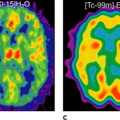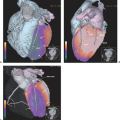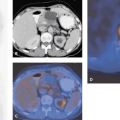PET and PET-CT of Small Cell Lung Cancer
Hans C. Steinert
Ehab M. Kamel
Small cell lung cancer (SCLC) is the most aggressive lung cancer. SCLC is characterized by rapid growth and early metastases, which are present in 60% to 80% of patients at the time of diagnosis. SCLC is associated with a poor survival prognosis, and it has a very strong association with cigarette smoking. It accounts for approximately 20% of all lung cancers. SCLC most often occurs as a large central mass with massive hilar or bilateral mediastinal adenopathy. In general, SCLC does not respond to surgical treatment. Occasionally, SCLC presents as a solitary nodule, which can be resected. In patients with disease confined to the thorax, radiation treatment will be performed. However, the 2-year survival rate is approximately 20%. Patients with extended disease are managed with chemotherapy. Integrated positron emission tomography (PET) and computed tomography (CT) imaging is an accurate method for the assessment of the total tumor extent and plays an important role in the planning of radiation treatment.
Classification and Staging
Small cell lung cancer (SCLC) is the most aggressive type of lung cancer. SCLC is characterized by rapid growth and early metastases, which are present in 60% to 80% of patients at the time of diagnosis, and SCLC should be regarded as a systemic disease regardless of stage (1). SCLC is associated with a poor survival prognosis. According to the Veterans Administration Staging System, SCLC is generally classified as either limited (LD) or extensive disease (ED) (2). Limited disease is present when the disease is confined to one hemithorax, the mediastinum, or supraclavicular nodes, which can be targeted with a single radiation portal field (Figs. 39.1 and 39.2). Disease extension outside the thorax or the existence of malignant pleural effusion is considered to be extensive disease (Fig. 39.3). Patients with SCLC are generally not candidates for surgery. Patients with extensive disease receive chemotherapy alone. In patients with limited disease, a combined radiation therapy and chemotherapy approach is used. However, staging SCLC according to the more specific TNM categories is useful and may be required for selecting patients for multimodality programs (3). Recently, in selected patients with limited disease, a multimodality therapy with hyperfractionated radiation therapy and chemotherapy followed by adjuvant surgery was claimed to have a favorable prognostic outcome.
Stay updated, free articles. Join our Telegram channel

Full access? Get Clinical Tree







